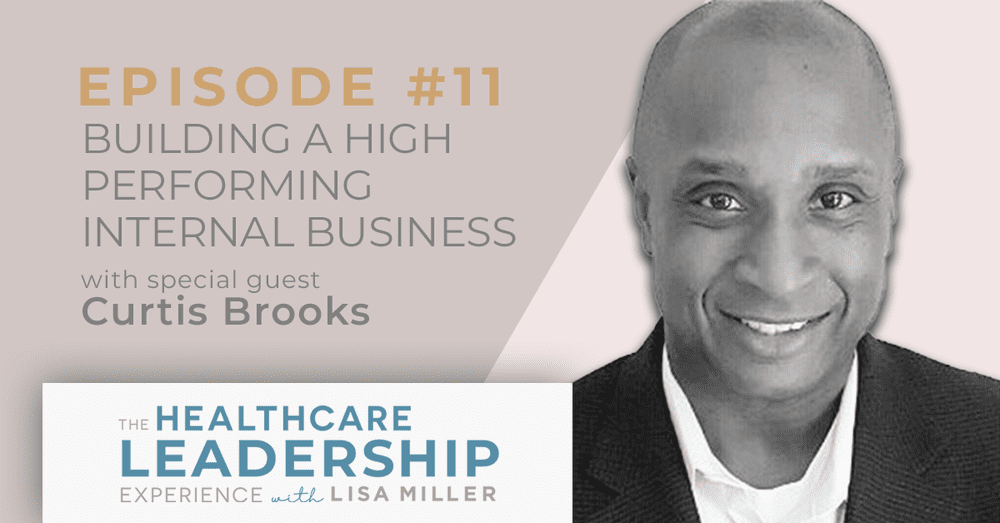In Episode 11 of The Healthcare Leadership Experience, Lisa is joined by Curtis Brooks, Principal and Practice Director, The Magis Group. Curtis helps organizations think differently about engaging C-suite executives.
On those key presentations, Curtis observes “.. what I always communicate to my clients and I recommend, it’s not about how long the presentation is, i.e., the number of slides, it’s about how long it feels.”
Today’s episode is sponsored by Invoice ROI™, the only patented purchased services and indirect spend technology to manage, monitor and benchmark line item details.
In today’s episode you’ll hear:
- How to create a successful internal business case within your healthcare organization – and why PowerPoint is the ideal medium for success.
- The common mistakes made in business cases – and why context is key to communicate a persuasive pitch to hospital leaders and CFOs. (Hint, don’t always start with a problem statement).
- Why the big picture matters; or in the words of Lee LeFever “don’t miss the forest for the trees.”
- The common mistake most presenters make in their business case and why you need to focus on best practices and critical success factors. “…. The best way to persuade is to let your audience … persuade themselves.”
- Essential steps to lead your audience to discover the solution for themselves.
- The importance of structure in your presentation – and why it comes back to the effective use of PowerPoint.
- Why every slide needs an effective headline narrative. “…what is most memorable in a presentation is that headline narrative and whether or not you have structured in a full sentence to communicate the key takeaway from that slide.”
- In an era of Microsoft Teams and Zoom meetings, why your presentation needs to have a life of its own. “We call it the self-driving presentation or the autonomous presentation because it really needs to have that capability in today’s climate more so now than ever.”
CLICK HERE TO DOWNLOAD THE PDF TRANSCRIPT
Connect with Curtis:
📱 linkedin.com/in/curtis-brooks-34b4511/
📧 cbrooks@themagisgroup.com
🖥 themagisgroup.com
Connect with Lisa:
🖥 viehealthcare.com
📱www.linkedin.com/in/lisamiller/
Check out this episodes sponsor:
🖥 viehealthcare.com/category/invoice-roi/
CLICK HERE TO OPEN THE FULL TRANSCRIPT
Lisa Miller (00:00):
This is Lisa Miller and I’m the host of The Healthcare Leadership Experience. Today’s episode is sponsored by Invoice ROI, the only patented purchase services technology to manage, monitor and benchmark invoice line item details. Invoice ROI allows hospitals to rapidly get to the details of their spend without any manual work and to achieve cost savings in days — not weeks, months, or even years. Today our guest is Curtis Brooks. And we will be talking about positioning your internal business case. Curtis is the principal and practice director of the Magis Group. Curtis has a highly specialized practice helping organizations think differently about engaging C-suite executives. He has a client list that includes some of the biggest names in enterprise sales and of late, many start-ups and smaller firms who have to incorporate persuasive techniques in their sales presentations, business cases, or investor pitches. On today’s podcast, we will be discussing how to successfully create an internal business case.
Every organization has the need for their employees to create business cases — from new strategic initiatives to merger and acquisitions and for large purchases. Curtis will talk about the common mistakes that are made when putting together a business case and why it’s so important to utilize a framework when putting together your business case. You can meet Curtis on LinkedIn, Curtis Brooks on LinkedIn, or email him at cbrooks@themagisgroup.com, M-A-G-I-S group.com. If you’d like to learn more about VIE Healthcare, please go to our website, viehealthcare.com, and schedule a call with me to learn how we can support and accelerate your purchase services, margin improvement, and cost savings goals. Now let’s get started.
Announcer (01:52):
Welcome to The Healthcare Leadership Experience, a place where healthcare leaders will share proven strategies and innovative approaches to leading the clinical and business side of healthcare. This show is sponsored by VIE Healthcare Consulting, who’s proudly helped hospitals save over $700 million in non-labor costs since 1999. Here’s your host, Lisa Miller, founder and CEO of VIE Healthcare.
Lisa Miller (02:16):
Welcome Curtis. I’m so excited to have you on The Healthcare Leadership Experience and to have our discussion today about business cases. So welcome.
Curtis Brooks (02:26):
Thank you, Lisa. Great to be a part of the series and I’m really excited. I’ve enjoyed our work together. So I think this is going to be a great conversation.
Lisa Miller (02:38):
So we’ve had the fun and hard work, there was always some more hard work there, of you helping me and VIE and how we communicate, how we really present what we do for our clients. And I’ve enjoyed our work. I’ve learned so much and I’d really like the audience to get a little bit of background. We are talking about internal business cases and how we construct those. And if you could give everybody just some background on a little about you and your methodology and about really just our conversation today, about building a high performing business case that’s really effective.
Curtis Brooks (03:18):
Thanks Lisa. So my work with clients is really been focused on building the business case from the outside in. As you said in your opening, my focus really has been in the B2B space with organizations that have a mandate to engage a very senior audience. And, of course, what we’re talking about today is the internal case where you have managers, senior managers, directors, vice presidents, what have you, they have to present their case to seniority — maybe a CFO, the CEO, or even the board. So, for me, I’m fortunate enough to have the opportunity to see a couple dozen of these types of presentations a week in the work that I do. And I think what’s ironic is everyone makes the same mistakes. And through that, there are nearly identical success factors in building a business case that is persuasive and motivates the stakeholders to action.
So you and I were having this conversation a few days ago and I made the point that I recently heard a senior executive say he’s never seen a bad business case. That was really profound to me because, in essence, it’s all relative. So then the question is how does one business case stand out from another? And how can you get your request prioritized into the top of the list? And what’s complicated this, of course, is the pandemic. And as we’ve talked, budgets have been hard hit and the operating climate has a lot of uncertainty, chief buyers are more involved in investment decisions and it just has this crazy unprecedented level of spend scrutiny going on. And what was once these routine decisions now have potentially significant implications for the near and long-term.
Lisa Miller (05:22):
Yeah, absolutely. And you made a point earlier about these internal business cases or anywhere in the organization and so one of the goals of having this podcast was to bring experts and thought leaders outside of healthcare, as well as people that are within healthcare. And the reason why I thought it was going to be so insightful for you to come on the show — even though you’re helping us as a healthcare organization, but primarily your work is B2B, but I just saw so much value in helping hospitals and health systems with their internal business cases. And that could be anywhere from presenting to their board or presenting to the C-suite or even your value analysis committee.
These value analysis committees have to present to physicians or clinicians, and there is such a structure and a usefulness and I think you’re going to start to really unfold that, but there’s so much, like you said, so much happening now, and these decisions have to be made with a different level of thinking. So I’d really like to hear more. I have a little bit of an insight of what you’re going to get to, but I’m going to tease the audience a little bit about PowerPoint gets a lot of criticism, but it shouldn’t. And I don’t know if you’re there yet, but I’m looking forward to hearing how you unpack that.
Curtis Brooks (06:45):
Well, obviously in an internal business case, the formats can vary widely. Only because, of course, for the obvious — it’s internal and some people feel as though it’s more efficient to just put in position their business case into a Word document or some type of report, but you’re right. PowerPoint as a medium really does get so much criticism, but really when you think about it, it allows people to collaborate and negotiate, because it really it’s both visual and modular at the same time. So reading time is at a premium. So visual documents written in a summation type writing style are replacing the rambling text documents and that forces you to stage the argument incrementally. You want control in the presentation. I tell my clients all the time, control is really about controlling yourself. And for that reason, PowerPoint is the best format for ensuring you don’t get ahead of yourself. So as we talk about these common mistakes and I provide some recommendations on what to do differently, recognize that I’m looking at it through the medium of PowerPoint, and I’m not sure how much it applies to some of the other mediums.
Lisa Miller (08:16):
In our work together you’ve really have taught me how to be very, like you said, controlled and disciplined in how we work with our clients and learning that approach has had such an enormous impact just on how I communicate. And like you said, it’s control, but it’s controlling me. And so that I could share a message and I can share our findings or any kind of communication in a very effective way. And I believe that what you’re going to speak about now is really the what is that format? What is that methodology that really creates a strong internal business case?
Curtis Brooks (08:58):
So let’s transition then from the lens of PowerPoint to those mistakes that I alluded to earlier, and I will just comment on them one at a time, and I’d say the first is really this idea that business cases should be structured around a problem statement or a need solution impact approach. I see this all the time. For example, if someone’s recommending a new way to perhaps improve an accounts payable processing procedure, they’ll start out by saying the current procedure involves 15 manual steps and the time it takes means we’re losing discounts as a result of that particular need. So then they’ll transition into what they’re proposing, a new system that will do everything from stored data and do the documentation and automate. And then they, of course, punctuate it with this whole comment about here’s how we get it deployed, here’s when we can see some type of return, here’s how the new technology is going to impact the manual aspect of what we do and here’s how we’ll recoup our investment.
So it always generally starts with some problem or problem statement. And I would highly recommend that you look at resequencing that pitch or that argument in the business case. And I think one of the keys is to ensuring that business case is persuasive is really to establish context. Now that seems rather straightforward and simple. And while we understand that context is important, we generally fail to deliberately choose a context because we believe that the context of the recommendation is obvious. So what I always try to communicate to my clients is that context is really so important to any communication, particularly in business case settings — because it provides a place for people and ideas to come together.
So what I mean by that is if we take the point I made earlier in the outline of a typical problem statement of a business case, one that starts with a problem statement, and then you shift it to one that has context, the way you might start that is suggesting that well, first the current operating climate, new competitors, and increasing regulatory pressures are forcing us to enhance the customer experience and the evidence suggests that our back office can play a role in preparing us for the future. Then, and only then, do you start transitioning to that commentary about what the real problem is in the processing procedure.
Lisa Miller (11:59):
So Curtis, I love this point and I just want to sit on it just for a minute because it is habit or I don’t know why that it is that we would launch right into the problem. The problem is we don’t have time or resources and just we focus on the problem when looking at this big picture view or the vision, I think, it’s a very key aspect of putting together a business case. Because you said it earlier, these decisions are so important now and there’s probably so many more of these business cases being made and hospitals like your example — whether it’s a new accounts payable automation system, or if it’s a new technology or new IT or a system, whatever it is, formulating this business case with a big picture view, I think, it’s so important, because it ships it to, I think you and I have spoken about it, it’s inspirational and it lines stakeholders.
Curtis Brooks (12:59):
Exactly. And I mean, really, if your recommendation or idea exists without a foundation, then it’s isolated and that isolation limits its potential. There’s an author, fellow by the name of Lee LeFever, he’s got a great analogy when he talks about this whole comment of you’ve heard the phrase of “you’re missing the forest for the trees”. Well, what he says in explaining context is it means that you are so focused on the detail and you’re missing the big picture and the trees are great and can be very helpful but information about the forest is really what makes them useful. So the idea is to start your business case by really creating a sense of agreement, when you start it with that big picture, you get heads nodding. And the most elegant way to approach that is really to take the advice of someone like a Simon Sinek, a great marketer who says start with why, and that why is almost most often the big picture. And as you said, it’s more inspirational, but at the same time, when you eventually convert that business case into a project plan, assuming it’s approved, of course, with milestones, then you can ensure that there’s alignment of all the key stakeholders.
Lisa Miller (14:24):
Yeah. It’s just brilliant. And I have now really as I’m presenting or we’re putting together our findings, reports or anything we’re doing that just that shift, it makes a big difference, so can you continue? I know you’ve got…
Curtis Brooks (14:39):
A couple of others. I’d say the second real common mistake is I see most presenters, they use a very logically-sound argument, but it’s persuasively very poor. In other words, they present the facts, but they’re not really sure how to persuade. And there’s a lot of evidence that suggests that really the best way to persuade is to let your audience discover their own reasons. In other words, persuade themselves. Instead of coming out and telling the audience the answer directly, let them have a role in the story. In other words, what you’re trying to do, you’re not really persuading, you’re getting people to persuade themselves, such that when they get to the answer, the answer isn’t just any answer or the recommendation — it’s their recommendation.
What I always like to see in my clients pitch in the B2B environment is you want the customer to reach the preferred conclusion before you actually introduce it in your presentation. And it inspires the customer to discover their own reasons for that change or recommendation of selection, but most importantly, what that does is they trust it more. So I would recommend that rather than thinking about a structure that is oriented around just the facts and the logic, get to a point where you’re getting some agreement from those customers about what the best practices are, what the critical success factors are — and once they’ve acknowledged those, then highlight your recommendation and how it aligns to it.
Lisa Miller (16:27):
Can maybe help our audience at this point, because this is the real thinking behind building this business case. So they’ve got to think, what are those success factors needed if we’re going to engage physicians or we’re going to agree upon a potential merger or present to the board. So can you just give an example or two?
Curtis Brooks (16:55):
Well, I would think those success factors, the easiest way to get to it is really to put them in the context of what is a best practice or what is critical success factor. And what you’re actually doing is using the narrative and the language that’s associated with your recommendation when you set up that best practice or critical success factor.
Lisa Miller (17:18):
That’s right. You’re building it from where you see the benefit of the business case. So that’s just for clarity because for me, once I got this point, it really was really transformative. So the person building the business case has specific reasons or has a vision, but they’re building these themselves as success factors. Is that correct?
Curtis Brooks (17:41):
That’s correct. And what they’re really doing is setting up their presentation to invite agreement before the recommendation, so if you invite agreement and you gain agreement in those best practices or critical success factors, then it’s going to be much easier to transition to how your recommendation aligns to it.
Lisa Miller (18:04):
So that business case will have these are the critical success factors, these are best practices and then as you’re moving through the business case, heads are nodding and everyone’s in agreement as you move towards, like you said, that recommendation. And so I think, again, a really important point to shift because the person thinking about this business case has to start creating that, so they gain alignment. They gain, like you said, I love the people are discovering their own reasons, but really it’s a planned process, right? It’s a format?
Curtis Brooks (18:38):
Precisely right. Again, you’re essentially getting them to persuade themselves, which obviously creates some efficiencies in the overall process.
Lisa Miller (18:47):
That’s right. And so I just want to take a step back for a minute. So, maybe if someone’s thinking well, that’s a really sophisticated or you’re almost playing chess. But you could see it that way, but I think what we’re trying to do here, remember this is an internal business case, someone in the hospital is saying, “Look, we need to buy this or we need to merge, or we need to make this decision on strategy,” and so if this initiative is so important, well, you’re going to want to put this effort in and rethink an approach so that it is successful, it does get approved. I want to make sure that the contents of this business case, you want to put that thinking and effort in because it’s an important initiative. And so if it’s so important, you want to lead with a big picture view, you want to start building out what are those best practices to gain alignment because this is meaningful to the hospital.
Curtis Brooks (19:42):
Yeah. And one clever way to position it might be to stage it in a world-class context. So if you can get your audience to agree on some critical success factors or what is world-class, then once they agree to it, you just have to ensure that your recommendation aligns to those attributes. And it just creates so much efficiency in ensuring that you get agreement from your audience.
Lisa Miller (20:16):
So, when you say you use PowerPoint and you use PowerPoint in a very unique way. There is written text, but you format your PowerPoint in a very logical way. So there’s sentences, you have images, but I would encourage those listening to reach out to Curtis, I’ll give you a way to reach out to Curtis at the end of the show, but he’s got a brilliant way on how he formulates a PowerPoint so that it’s… Can you just talk a little bit about the titles because I know we’re shifting a little bit, but I think it’s important because people think of PowerPoint, they’re thinking lots and lots of pictures and one word or two words. The way you structure your PowerPoints in those pages is your own format. Can you just talk a little bit about it before we go into…
Curtis Brooks (21:07):
Yeah. So, that’s actually a good segue because the structure of the presentation is extremely important in the aesthetics and so on and so forth. It’s a segue toward the comment I was going to make around one common mistake is that there’s this idea that the presentation has to be very crisp and concise, and we’ve all heard that, make it short, make it direct, make it hit the key points immediately. But what I always communicate to my clients and I recommended, it’s not about how long the presentation is, i.e., the number of slides, it’s about how long it feels. So you can, in essence, have a 5-page PowerPoint presentation that feels like 40 pages and 40 minutes, but you can also have a 40-page presentation, it feels like 5 minutes and it really points to how you structure the content in each slide, and then how you narrate that content.
So I am asked all the time, what does a great presentation look like? And when I get that question from someone, what I generally do is show them an outline of the slides. Not the actual PowerPoint, but an outline of the slides, the headlines, and how they’re organized. That generally exposes where the real flaws are. And when you convert that PowerPoint to a Word outline, you can review it for flow and clarity. And one of the errors that I typically see is that the headline narrative, there’s generally a disconnect between what the presenter intended to say and what the headline narrative says.
This is the point you were making a few minutes ago, one way to fix that is to ensure that your headline narrative has full sentence headlines, and that forces a discipline on your ideas and how you communicate when you are focused on creating a headline narrative that is associated with the key takeaway of the visual on each slide. It sounds simple, but once you go through that mental exercise, and then actually put it to paper, it becomes really challenging. But if you can make it work, if you can synchronize that full sentence headline with the graphic or the illustration or the aesthetic, it makes a huge difference in the flow and the clarity — then you’ll find that perhaps a 20-page PowerPoint presentation feels shorter than a five page presentation only because you’ve got the right narrative and flow associated with it.
Lisa Miller (24:11):
And I also feel like when you’re looking at that page and you have a 2 or 3 words, it’s a summary that maybe makes sense to you. Or I can speak for myself, sometimes when I’m putting together a presentation I know what I mean and I put it on top and it’s summarized, other people won’t have that same thought or context. And now I’m always putting that full sentence and it’s easier for them to understand, it’s easier for them to pull everything together, no one’s guessing or like, “What does she mean by that?” vs. I have a sentence and it’s clear. But that’s thanks to you.
Curtis Brooks (24:48):
That’s precisely right. And there’s a lot of research. It’s fascinating. There’s a lot of research on the impact that full sentence headlines make. So, part of the impact is: it is the one aspect of any presentation that makes it more memorable. And that’s fascinating because most people will say, “Well, what makes a presentation memorable are the visual, the aesthetics, the way it looks, the presenter, maybe some humor or what have you.” But ironically, what is most memorable in a presentation is that headline narrative and whether or not you have structured in a full sentence to communicate the key takeaway from that slide.
Lisa Miller (25:30):
Yeah. I think there’s probably going to be a dozen plus important points that people are going to take away from this show, but that one is definitely a big one. It’s just this thinking through your business case, putting it into PowerPoint and having that clarity and putting that full sentence key takeaway up top on the PowerPoint is very important, right?
Curtis Brooks (25:57):
Extremely important, of course, in this climate, because you’re presenting in formats that are awkward for everyone — whether it’s Zoom or Microsoft meeting or what have you. And you’ve got an audience staring at a slide, so you’re presenting your business case and you’ve got an audience who might be focused on an illustration or a visual, but their eye is going to take them to that headline narrative. And if the headline narrative has the key takeaway, it’s going to make a huge impact into how they retain that information.
Lisa Miller (26:30):
It’s a really good point about the world we live in now is virtual and Zoom and how we have to think about how we present.
Curtis Brooks (26:38):
And the last point I’ll make in terms of common mistakes is usually in a recommendation what I typically see is someone will outline a menu of the specific attributes of their recommendation and why those attributes or characteristics are important. But I would recommend that you try to avoid that format because really what it does is it sets up a comparative exercise on these specific attributes. And it’s actually not particularly memorable. So instead, what I try to suggest to my clients is they visualize a Venn diagram. And rather than just outline a menu of capabilities, they think about the combination of those capabilities and the attributes, how those work together — and then they position their recommendation around the intersection.
And that is a very powerful way to run interference on what are almost always a set of inconsequential objections. And you and I have talked about what an inconsequential objection sounds like and I got to imagine that they emerge in a business case presentation or business case document. If you can package those attributes and those characteristics of whatever your recommendation is in a way that highlights a combination of how they come together and how they work together. And then that intersection, of course, becomes your recommendation, it really helps on a persuasive level.
Lisa Miller (28:20):
This is one of my favorite parts and actually, somebody yesterday, I was having a conversation and they said, “Oh, well, the reason they chose you for a project was because of X.” And I’m like, “Yes, but no, it was…” And now because of Curtis, I’m like, “No, it’s the combination of one, two, and three is the reason why we were chosen, not one.” But it happens to be the truth. I don’t really believe that it’s ever this one reason, but in this context, I wanted to have a discussion with you about it because I… Maybe give an example.
So let’s say a hospital is looking to buy a large piece of equipment for the, OR, and like you said, all these attributes, you list all the attributes versus creating a Venn diagram that says, “This will lead us to be able to be known regionally for innovative care and align the physicians,” or you’re probably better…of course, you are better at this than I am. But I think talking about those three reasons as it has to be an intersection in order for this to be successful, it’s not any one or two, it’s the intersection of three or four.
Curtis Brooks (29:39):
That’s exactly right. In the B2B world, that’s where we create differentiation. In the business case world, that’s where I think your recommendation can become most powerful. Again, the goal is to run interference on a set of objections that really don’t challenge the business case or the ROI. And in that way, you are ensuring you’re gaining some agreement that yes, the combination of these attributes is going to be critical for us and that’s why you’re making that specific recommendation.
Lisa Miller (30:17):
So in the case of starting a new project, the benefits of the proposed business change, you’re putting that together for those reasons.
Curtis Brooks (30:27):
Right.
Lisa Miller (30:27):
And I didn’t ask this before, but maybe for those who reach out to you, I think you would show some examples on this format, on your business format. And unfortunately, unlike a webinar, we could show some of this, but on a podcast we can’t. But there’s a methodology. Communication, whether it’s verbal communication or particularly in these presentations for business cases, there’s a successful way to put these together. And you have a methodology, Curtis, that organizations use globally and from the top brand name businesses throughout the world, they’re using your methodology. And this methodology is able to communicate ideas, vision, strategy. I mean, it works. It really does.
And I still have one more question before you go, but I really encourage those that are listening to the show, if you have a business case, some of these as you’re putting together your strategy, or you’ve got to make a presentation internally at your hospital, I’d encourage you to reach out to Curtis. He does great work, whether it’s one-on-one or he does some virtual training, but he not only has a proven, brilliant methodology, he also cares. And he cares about the success of his client. And that really matters.
Curtis Brooks (31:55):
Thank you.
Lisa Miller (31:56):
You’re welcome. So, as we’re wrapping up, could you maybe think of, or give our audience maybe a one or two more tips? You’ve given out so much information. I saw your prep and it’s extraordinary. There’s a lot of strategies you’ve given us today, but maybe one last one or two.
Curtis Brooks (32:15):
I would say it’s less of a tip and more about the outcome of building this correctly, and often folks tend to miss this is that these presentations, and it’s particularly in today’s climate, they really have to have a life of their own. So much of the selling with my clients, the B2B selling, is now done absent the sales team’s ability to engage the client live. So their documents, their assets, those artifacts have to sell themselves in their absence. So some of these suggestions, recommendations they are providing, are going to really help your audience achieve that because they need to ensure that when that document is passed along, distributed internally — whether it’s a very senior executive or the CEO or the board, they can read it and consume it without the verbal narration that is typically required or associated with those documents.
And whether it’s everything from the headline narratives to the way in which you package that set of capabilities, or even how you arrange those critical success factors to get them to persuade themselves, it’s so important that you ensure that the document has a life of its own. I like to phrase it with my clients, we call it the self-driving presentation or the autonomous presentation because it really needs to have that capability in today’s climate more so now than ever.
Lisa Miller (34:07):
I love that, autonomous. But it’s true. So you want to be able to have a business case that can sit independent and be reviewed, and someone’s able to do what you spoke about today, which is create the big picture, the vision, put together those critical success factors in a way that’s understood, that gets them buy-in and alignment and really shows that there’s the intersection of those attributes are put together in such a way that the business case, it works itself or is elevated to the point of that decision does get made or it moves that along further, so it does need to be autonomous.
Curtis, thank you for that last part, because I think that’s important too, sometimes we pick up some of those presentations and you look, and you’re like, “I don’t know what we’re looking at,” or you get the Word document that’s 10 pages or a book and I think that’s also something that may not get read as thoroughly as what you’ve put together which is, again, your methodology on creating a presentation that really does achieve the outcomes. So Curtis, thank you so much for being with us today.
Curtis Brooks (35:22):
My pleasure, Lisa.
Lisa Miller (35:23):
And can you just give everyone your email please?
Curtis Brooks (35:26):
So it’s Curtis Brooks on LinkedIn, of course. That’s one way to connect with me. The other is through my business email address, it’s cbrooks, first initial, C, B-R-O-O-K-S, cbrooks@themagisgroup.com, T-H-E M-A-G-I-S dot com. Look forward to having a conversation with someone if they’re interested in learning more.
Lisa Miller (35:53):
Yeah, absolutely. And I encourage everyone to reach out to Curtis with your communication written business case needs and even just for your teams and as they need training, this is a spectacular way to help communicate your strategy and goals in the organization. Curtis, thank you. I look forward to talking with you soon.
Curtis Brooks (36:18):
Thank you, Lisa.
Announcer (36:19):
Thank you for listening to this episode of The Healthcare Leadership Experience. If you enjoyed today’s show, please leave us a review. Your reviews help other healthcare leaders find this podcast and see the value that it provides. If you’re a healthcare leader who would like to be on the show, or if you’d like to listen to more episodes and view our show notes and resources, please visit us at thehealthcareleadershipexperience.com. Thank you for listening and we’ll see you again next week.











